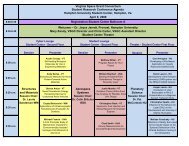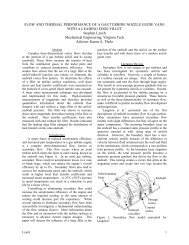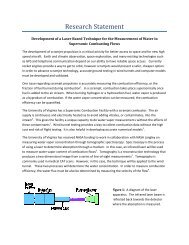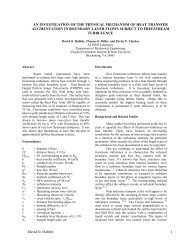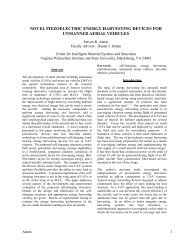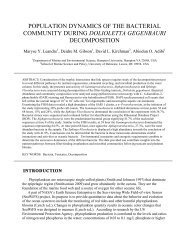Enhancing Model Understanding Through Static Analysis
Enhancing Model Understanding Through Static Analysis
Enhancing Model Understanding Through Static Analysis
You also want an ePaper? Increase the reach of your titles
YUMPU automatically turns print PDFs into web optimized ePapers that Google loves.
ENHANCING MODEL UNDERSTANDING THROUGH STATIC ANALYSIS<br />
Kara A. Olson and C. Michael Overstreet<br />
Department of Computer Science<br />
Old Dominion University<br />
Norfolk, VA 23529-0162<br />
{kara, cmo}@cs.odu.edu<br />
Abstract. Simulation is used increasingly throughout the sciences for many purposes.<br />
While in many cases the model output is of primary interest, often the insight gained by<br />
the modeler through the simulation process into the behavior of the simulated system is<br />
the primary benefit. This insight can come from the action of building the model as well<br />
as observing its behavior through animations, execution traces, or statistical analysis of<br />
simulation output. However, much that could be of interest to a modeler may not be<br />
easily discernible through these traditional approaches, particularly as models become more<br />
complex.<br />
<strong>Static</strong> code analysis techniques can reveal aspects of models not readily apparent to the<br />
builders or users of the models, even when applied to relatively modest simulation models.<br />
Using a commercially available static code analysis tool, we were able to find documentation<br />
errors in the published paper, “Redundancy in <strong>Model</strong> Specifications,” by Nance, Overstreet<br />
and Page [8]. This additional information about model properties is unlikely to be detected<br />
in executing the models and contributes to the insights gained by modeling a complex<br />
system.<br />
Introduction & Motivation<br />
It is often stated by users of simulation that the<br />
primary benefit is not necessarily the data produced<br />
by the model, but the insight that building the<br />
model provides. At the most recent Winter Simulation<br />
Conference (December 2005), Paul et al. discussed<br />
this [10], noting that “simulation is usually<br />
resorted to because the problem is not well understood,”<br />
and more often than not, the simulation is<br />
no longer of interest once the problem is fully understood.<br />
We believe the static analysis techniques<br />
such as those discussed here can be used to enhance<br />
their understanding and complement insights gained<br />
through model execution.<br />
Insights can arise from many different sources.<br />
One can be surprised to learn that one event causes<br />
another seemingly-unrelated event. One can also<br />
gain insight when something that is expected to happen<br />
does not occur. Sometimes events can happen<br />
with regularity or as clusters which may not be noticed<br />
by a modeler and may reveal important aspects<br />
of the simulated system. Often these facts are not<br />
immediately obvious, particularly in large simulations<br />
[9, 8]. Anecdotal reports from modelers support<br />
the frequent difficulty of detecting important<br />
aspects of their models which when pointed out are<br />
quite useful. <strong>Static</strong> analysis of models has the potential<br />
to help a model builder interactively explore<br />
different properties of the model such as causal relationship<br />
among model components.<br />
Automatically generated information about models<br />
has the potential of overwhelming users with too<br />
much information; using interactive static code analysis,<br />
it may be possible to offer the right information<br />
at the right time. For example, in an experience of<br />
Overstreet, a model-coder was studying the implementation<br />
of a model. Upon running it, it was noted<br />
that every event in one group occurred exactly the<br />
same number of times. Once this was observed, it<br />
became obvious that the model structure dictated<br />
this; however, having the right information at the<br />
right time could have enhanced understanding earlier<br />
than at the end of the implementation. As will<br />
be described shortly, in a project whose objective
was to explore the ability of existing code analysis<br />
tools to provide model information to modelers, a<br />
static slicing tool was used to analyze a model [8]<br />
and errors were found in the published documentation<br />
of the model. Although the goal was not<br />
to check for errors, the tool clearly could be used<br />
to provide better documentation and hence a more<br />
complete understanding of the model.<br />
These analyses have other obvious uses including<br />
aid in debugging, verification and documentation.<br />
We, however, are primarily interested in how these<br />
analysis techniques can be used to help a modeler<br />
gain additional insights into models s/he is using or<br />
constructing.<br />
Similar Work<br />
Program visualization and abstraction are similar<br />
notions [3, 7]; however, our objectives are often different<br />
from those of the program visualization community.<br />
In our work, the modeler may benefit from<br />
understanding the details of the model as it is realized<br />
in source code since the source code is the<br />
true specification of the model as executed. Alas,<br />
source code involves many issues unrelated to modeling,<br />
such as data collection, animation, and tricks<br />
for efficient run-time behavior. Unless the modeler<br />
is an expert programmer, this other code tends to<br />
obscure the model as implemented. The analysis<br />
techniques we discuss can help a modeler better understand<br />
a model as it is being constructed. By providing<br />
feedback, such as casual relationships, they<br />
can also help modelers better understand existing<br />
models.<br />
In compiler optimization, several techniques are<br />
used routinely that could potentially provide useful<br />
insights to the modeler. Data flow analysis is used<br />
to help identify data dependencies – that is, to help<br />
identify relationships among different parts of the<br />
code. This analysis also can help determine interactions<br />
among variables in different model components<br />
– something of which the modeler might not be so<br />
aware.<br />
An example of information which can be produced<br />
through data flow analysis techniques (though<br />
the ease with which this can be done depends on<br />
the model representation used) is the identification<br />
of both the events which can cause each simulation<br />
event, and those events which can be caused by each<br />
event. If these lists can be generated, they can be<br />
informative by possibly identifying unanticipated effects<br />
previously unrecognized by the modeler. They<br />
can also serve a diagnostic purpose if the list omits<br />
events the modeler knows should be included, or includes<br />
events the modeler knows should not be included.<br />
Control flow analysis, also from compiler optimization,<br />
can be used to determine which variables<br />
control which behaviors, something a modeler could<br />
possibly overlook. Control flow is especially useful<br />
for parallelization, something being done more often<br />
due to the size and complexity of newer models.<br />
Using even these kinds of analyses, one can detect<br />
unrealized relationships, both causal and coincidental:<br />
relationships among different code modules,<br />
or relationships among different simulation components.<br />
Some of the graphs we consider are similar to<br />
Schruben’s event graphs [12], though as our objectives<br />
differ from Schruben’s, the information in the<br />
graphs differ.<br />
CodeSurfer<br />
CodeSurfer is a software static analysis tool based<br />
on more than ten years of Defense Advanced Research<br />
Projects Agency (DARPA) sponsored research<br />
on system dependence graphs [2]. CodeSurfer<br />
is based on The Wisconsin Program Slicing Tool, a<br />
research project at the University of Wisconsin. It<br />
is designed to enhance program understanding using<br />
the system dependence graph of a program [1].<br />
A program dependence graph [5] is a directed<br />
graph that represents one procedure in a program. It<br />
uses directed edges to indicate dependencies among<br />
different parts of the code. A system dependence<br />
graph [6] represents an entire program and is usually<br />
a combination of multiple program dependence<br />
graphs. A dependence graph, as used in our work,<br />
is a directed graph that shows dependencies among<br />
the code used to define the behavior of each event.<br />
That is, if event b is caused by event a, then there is<br />
an arrow from event a to event b in the dependence<br />
graph. A solid line indicates that event a can cause<br />
event b at the same instance in time; a dashed line<br />
indicates that event a can cause event b at a future<br />
instance in time.<br />
CodeSurfer allows the system dependences graphs<br />
it makes to be queried in multiple ways. It also<br />
has multiple views that allow the user to view the<br />
parts of the code that s/he finds relevant at the<br />
time. These viewers are connected through hypertext<br />
links. CodeSurfer obtained its name since it<br />
“allows surfing of programs akin to surfing the Web”<br />
[1]. One such view looks at a backward slice.<br />
Program slicing [13] is a technique for finding a<br />
subset of a program that relates to the parts of the<br />
program that are of current interest. For example,<br />
Olson and Overstreet 2
say one were to have a statistical program that finds<br />
mean, standard deviation and variance. If the latter<br />
two were found correctly but the former was not,<br />
it could be helpful to the programmer to only concern<br />
him or herself with only the bits of code that<br />
deal with obtaining the mean. This subset of the<br />
program would be a slice.<br />
A backward slice, as articulated in [1], is a slice<br />
of a program with respect to a starting point S that<br />
answers the question, “What points in the program<br />
does S depend upon?” In our work, multiple backward<br />
slices are used to construct the dependence<br />
graph of the model.<br />
Results<br />
Using CodeSurfer and working with backward<br />
slices, Olson was able to find several uncaught errors<br />
in [8], involving a simulation of a harbor model<br />
with a simple dependency graph as most models go.<br />
The main purpose of this graph, derived from source<br />
code, is to show which events can cause which events.<br />
In the harbor model from [8], ships arrive at a<br />
harbor and wait for both a berth and a tug boat to<br />
become available. A ship is then escorted to a berth,<br />
unloaded, and escorted back to sea. This model is<br />
used to study tug boat utilization and ship in-harbor<br />
time. This is a version of the harbor model which<br />
appears in [4, 11].<br />
In Figures (a) and (b), a move tug to ocean event<br />
can cause a deberth event to occur; also, a deberth<br />
event can cause a move tug to ocean event to occur.<br />
As mentioned earlier, a solid line indicates that<br />
event a causes event b to occur at the same instance<br />
in time, whereas a dashed line indicates that event<br />
a will cause event b at a future instance in time. A<br />
dotted line in Figure (b) indicates a correction or<br />
addition.<br />
These figures also illustrate a prime problem with<br />
model descriptions whether in textual or graphical<br />
notations: even in simple models, the descriptions<br />
are often difficult to fully comprehend (even when<br />
automatically derived from source code). The type<br />
of tool we hope to develop may help with the problem<br />
of having “too much information” by allowing<br />
the interactive exploration of a model so that only<br />
selected information is presented.<br />
Current & Future Work<br />
As we have noted, it is difficult to separate code<br />
that defines the model – and hence is likely of primary<br />
interest to a modeler – from code that is<br />
present in order to run the model – for example,<br />
the details of adding events to lists.<br />
We would like to be able to generate representations<br />
of different aspects of simulations such as:<br />
model representations which exclude implementation<br />
aspects; data collection representations which<br />
show only those parts of a model that effect particular<br />
statistics produced by the simulation; and<br />
model component interaction measures which might<br />
be useful for distributed simulations.<br />
One instantiation of this may use CodeSurfer.<br />
CodeSurfer facilitates extraction of a wealth of information<br />
from a program. However, most model users<br />
are not computer program experts. CodeSurfer is<br />
yet another tool that would have to be learned, remembered,<br />
and manipulated. Seldom does it seem<br />
worth the time costs and effort to use such a tool, regardless<br />
of what insight it may offer, and such tools<br />
are soon cast aside or forgotten.<br />
However, CodeSurfer comes with a Scheme (language)<br />
interpreter for extensibility. We hope to extend<br />
CodeSurfer such that a model user would only<br />
have to run our CodeSurfer script and obtain the<br />
dependence graph in a user-friendly, graphical representation.<br />
Certainly this would be more likely to<br />
be useful and to be used. With this information extracted<br />
and readily available, both understanding of<br />
the model and better evaluation of model correctness<br />
could be enhanced.<br />
Conclusion<br />
Our experience has been that often model information<br />
obtained through analysis seems embarrassingly<br />
obvious after it has been pointed out –<br />
sometimes even obviating the need for the model,<br />
as noted by Paul et al. [10]. Our goal is to provide<br />
modelers with new information about their models<br />
– not just facts of which they are already aware.<br />
Selecting information likely to be useful is a challenge.<br />
Providing a tool which encourages interactive<br />
exploration of model characteristics should support<br />
identification of new information about a model of<br />
interest.<br />
In this paper, we have discussed some of our initial<br />
work using CodeSurfer and how its ability to<br />
generate model representations directly from source<br />
was used to correct a manually-produced harbor<br />
model dependence graph published in [8], hence correcting<br />
erroneous model documentation and thus enhancing<br />
model understanding. We have also suggested<br />
one way CodeSurfer could be extended to be<br />
useful to others and enhance their understanding of<br />
their models.<br />
Olson and Overstreet 3
termination<br />
tug_arr_at_<br />
ocean<br />
tug_arr_at_<br />
pier<br />
move_tug_<br />
to_pier<br />
unload<br />
move_tug_<br />
to_ocean<br />
arrival<br />
initialization<br />
deberth<br />
enter<br />
end_deberth<br />
end_unload<br />
(a) The original dependence graph<br />
termination<br />
tug_arr_at_<br />
ocean<br />
tug_arr_at_<br />
pier<br />
move_tug_<br />
to_pier<br />
unload<br />
move_tug_<br />
to_ocean<br />
arrival<br />
initialization<br />
deberth<br />
enter<br />
end_deberth<br />
end_unload<br />
(b) The corrected dependence graph<br />
Olson and Overstreet 4
References<br />
[1] P. Anderson, T. Reps, and T. Teitelbaum,<br />
Design and implementation of a finegrained<br />
software inspection tool, IEEE Trans.<br />
Software Engineering, 29 (2003), pp. 721–733.<br />
[2] P. Anderson, T. W. Reps, T. Teitelbaum,<br />
and M. Zarnis, Tool support for fine-grained<br />
software inspection, IEEE Software, 20 (2003),<br />
pp. 42–50.<br />
[3] R. Baecker, <strong>Enhancing</strong> program readability<br />
and comprehensibility with tools for program visualization,<br />
in Proceedings of the 10th International<br />
Conference on Software Engineering,<br />
April 1988, pp. 356–366.<br />
[4] J. N. Buxton and J. G. Laski, Control<br />
and simulation language, Comput. J, 5 (1963),<br />
pp. 194–199.<br />
[5] J. Ferrante, K. J. Ottenstein, and J. D.<br />
Warren, The program dependence graph and<br />
its use in optimization, Trans. Programming<br />
Languages and Systems, 9 (1987), pp. 319–349.<br />
[6] S. Horwitz, T. Reps, and D. Binkley, Interprocedural<br />
slicing using dependence graphs,<br />
Trans. Programming Languages and Systems,<br />
12 (1990), pp. 26–60.<br />
[7] T. Jones, Diagrammatic presentation of software<br />
engineering documents, Tech. Rep. 95-6,<br />
Software Verification Research Centre, Department<br />
of Computer Science, The University of<br />
Queensland, Queensland, Australia, February<br />
1995.<br />
[8] R. E. Nance, C. M. Overstreet, and<br />
E. H. Page, Redundancy in model specifications<br />
for discrete event simulation, ACM Trans.<br />
<strong>Model</strong>. Comput. Simul., 9 (1999), pp. 254–281.<br />
[9] C. M. Overstreet and I. B. Levinstein,<br />
<strong>Enhancing</strong> understanding of model behavior<br />
through collaborative interactions. Operational<br />
Research Society (UK) Simulation Study Group<br />
2nd Two Day Workshop, March 2004.<br />
[10] R. J. Paul, T. Eldabi, J. Kuljis, and<br />
S. J. E. Taylor, Is problem solving, or simulation<br />
model solving, mission critical?, in Proceedings<br />
of the 2005 Winter Simulation Conference,<br />
M. E. Kuhl, N. M. Steiger, F. B. Armstrong,<br />
and J. A. Joines, eds., 2005, pp. 547–<br />
554.<br />
[11] T. J. Schriber, An Introduction to Simulation<br />
Using GPSS/H, John Wiley & Sons, Inc., New<br />
York, NY, 1974.<br />
[12] L. Schruben, Simulation modeling with event<br />
graphs, Comm. ACM, 26 (1983), pp. 957–963.<br />
[13] M. Weiser, Program slicing, IEEE Trans.<br />
Softw. Eng., SE-10 (1984), pp. 352–357.<br />
Olson and Overstreet 5



